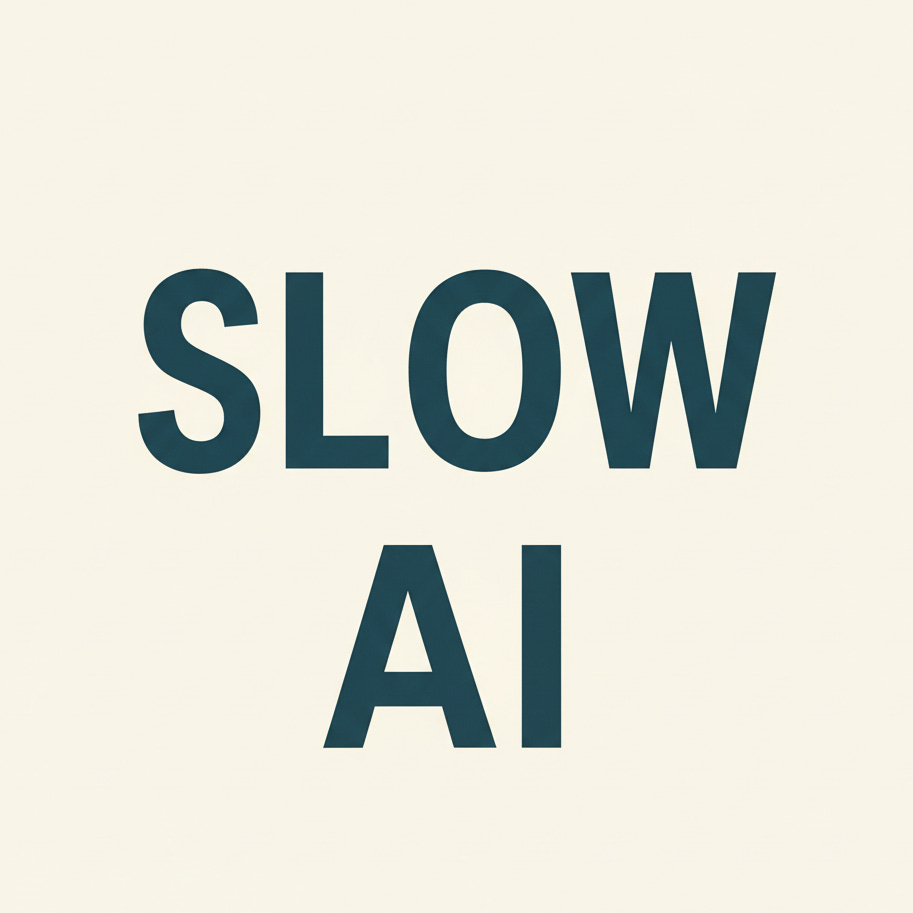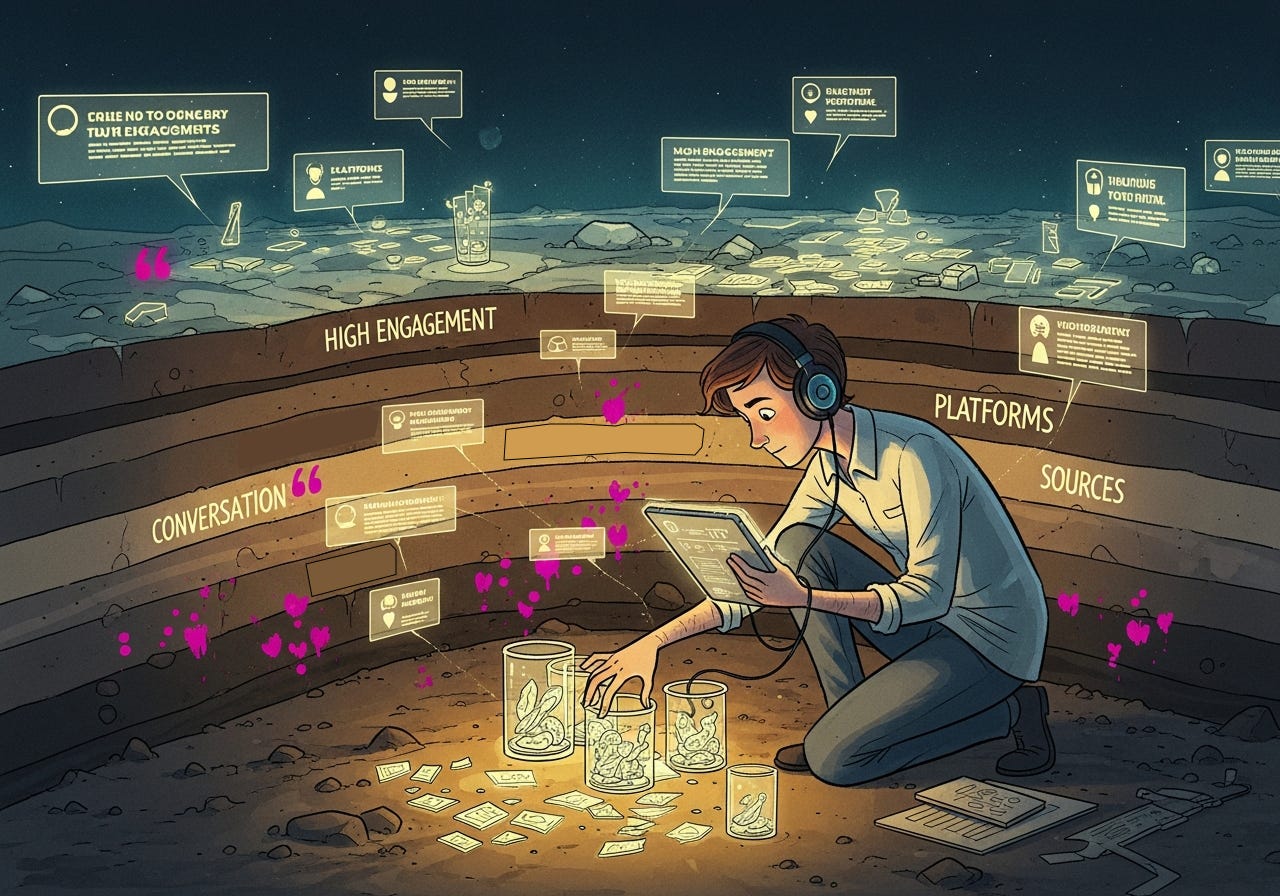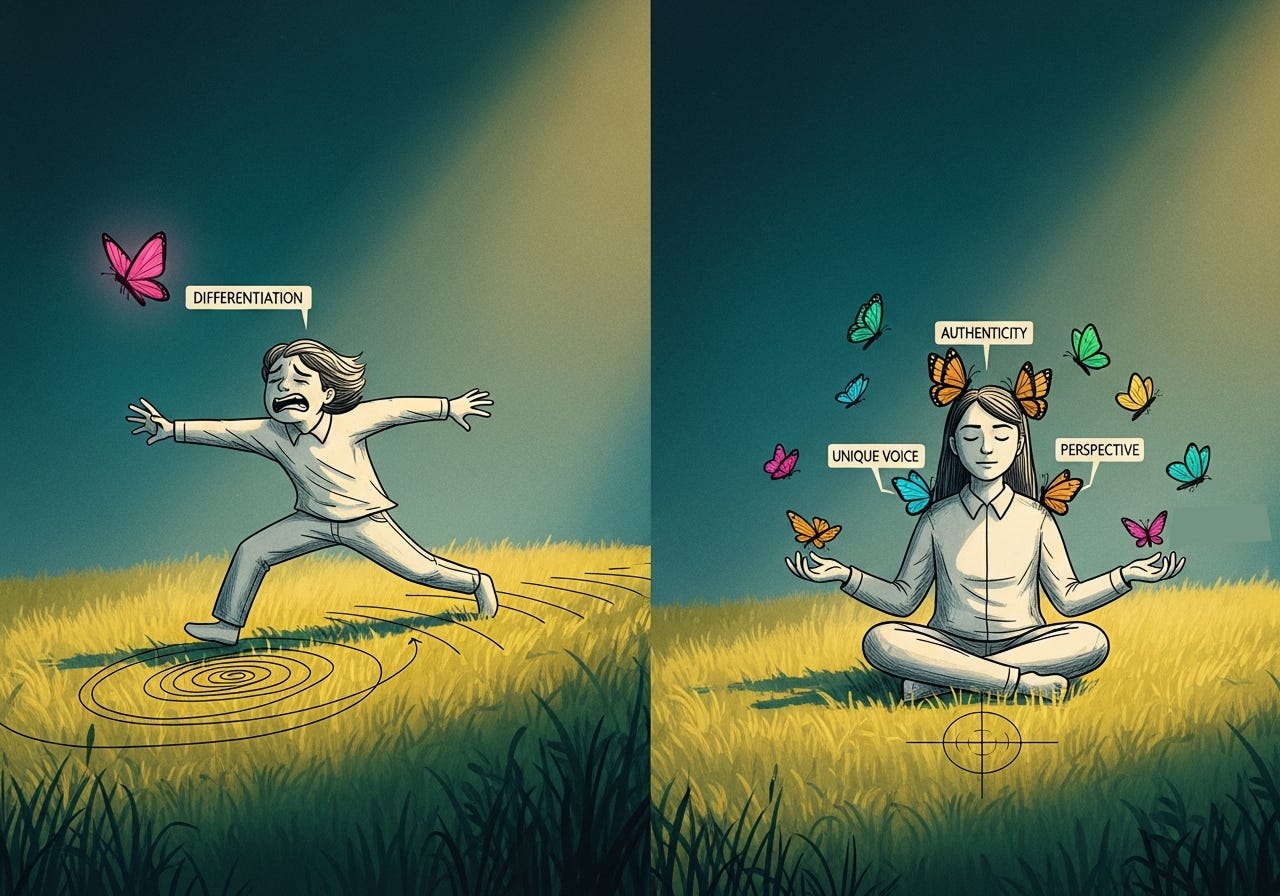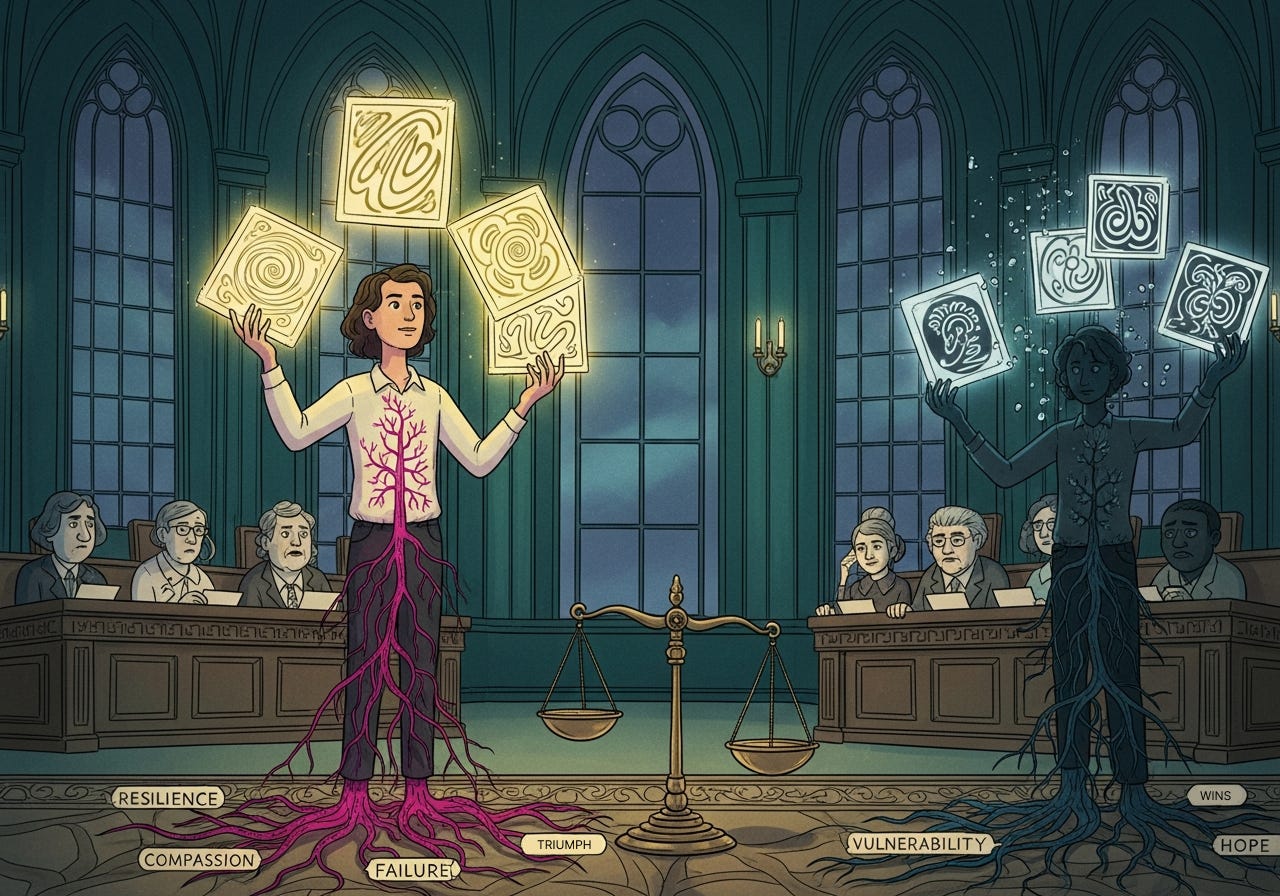Everything worth keeping happens between the prompts
Why the fastest AI workflows produce the weakest ideas and exactly how to fix it with deliberate pauses.
Welcome to today’s edition of ROBOTS ATE MY HOMEWORK. Today we’re building a deliberate pause into your AI workflow.
In 1952, composer John Cage wrote 4’33”, a piece where the pianist sits at the piano for four minutes and thirty-three seconds and doesn’t play a single note. The composition forces listeners to hear everything they normally ignore so the ambient sound of being alive becomes the music.
Cage wasn’t the first to understand that silence matters. Johann Sebastian Bach placed rests in his scores too.
I’ve been playing piano since I was 7 years old, and it took twenty years to understand that the silence between notes is not a pause but a presence. That absence, paradoxically, is the most active choice a musician makes.
This idea that silence is as important as sound is why I’m thrilled to be collaborating on today’s edition with
from Slow AI.In his newsletter, Sam is exploring what happens when we slow down our work with AI.
And today, we’re building something together: a workflow that treats the pause as an essential next step.
Here’s what we’ll explore, slowly:
The 5-step “Intentional Pause” workflow that forces human perspective into AI-generated content strategy
Why the most powerful systems are the ones with intentional friction (not despite it)
A philosophical principle that explains why chasing “more ideas” makes your ideas worse
The problem - what you lose when everything flows
We’ve adopted AI to move faster and ship more. On the surface, it’s working.
Problem is, the arguments are interchangeable. They sound like they could have been written by anyone with access to the same LLM because they were.
Most AI workflows optimize for one thing: speed.
Question → Research → Ideas → Content.
No pauses and no moments where you actually show up and make a decision that only you can make.
Quick diagnostic: Do you have the “Generic AI Voice” problem?
Before we go further, answer these three questions:
When you re-read your last piece of content, could you imagine your main competitor writing it?
Has anyone in the last three months said “This sounds like you” about your AI-generated work? Or do compliments come with confusion, like they’re trying to figure out who this is?
When you brief an AI tool, do you tell it what you think, or do you ask it to find what everyone thinks?
If you answered YES to #1 or #3, or NO to #2, this system was built for you. Keep reading.
When you let the machine take over completely, a strange quiet begins to form.
At first, it feels efficient. The words appear without effort, shaped and polished, ready for use. But over time, you start to feel a thinness behind them, as if the pulse that once guided your work has slipped away.
What vanishes is not the content but the resistance. The pause before a sentence, the moment of doubt that asks if it should exist at all. When everything moves too smoothly, nothing truly sticks. The friction that once gave shape to your thoughts becomes invisible, and without it, your ideas lose weight.
The thinness you feel might be the absence of what philosopher Michael Polanyi called tacit knowledge: the embodied, felt sense that can’t be fully articulated but that guides authentic work.
That is the moment to stop and listen. The feeling of detachment is a signal that something human has been left behind, waiting for you to return and reclaim it.
What exactly has been left behind?
Good (or bad) news: it’s your unique perspective, the irreducible bottleneck. The particular way you see the problem, shaped by every failure you’ve survived and every insight you’ve earned.
BEFORE THIS WORKFLOW:
You ask: Generate 50 content ideas
You get: Ideas that sound like everyone else
You feel: Detached from your own work
AFTER THIS WORKFLOW:
You ask: Targeted questions rooted in your lived experience
You get: Ideas only you could own
You feel: Like an architect, not an automaton
Here is a system that treats the pause as the main event.
Step 1: The raw listening
(Like Cage recording ambient sound; no interpretation)
The goal is first to collect evidence without interpretation.
Use AI to gather raw competitive intelligence around a specific topic, audience pain point, or market you’re entering.
Most people jump straight to synthesis, which means they filter information through their existing biases. But through this prompt, you’re first creating a moat against your own assumptions:
You are a competitive intelligence analyst with access to real-time search. Your task is to map the conversation landscape for [specific topic/audience pain point].
CONSTRAINTS:
- Time range: Past 6 months only
- Sources: Mix of high-authority publications (30%), niche communities (40%), and contrarian voices (30%)
- Minimum 3 sources per data point
- Flag any claims that appear in multiple sources without attribution
OUTPUT STRUCTURE:
1. HIGH-VELOCITY CONTENT (What’s getting shared):
- Title, publication, share count, key argument
2. COMMUNITY PAIN POINTS (What’s being asked repeatedly):
- Question verbatim, platform, context, frequency
3. COMPETITIVE FRAMING (How competitors position this):
- Company/creator, angle, sentiment, evidence
4. CONTRARIAN POSITIONS (What’s being said against the grain):
- Argument, source credibility, engagement metrics
QUALITY THRESHOLD:
Each section must contain at least 8 distinct data points. If fewer than 8 exist, explain why this topic has low information density.
Do NOT synthesize. Do NOT editorialize. Present raw intelligence with metadata.You’ll get back a mess of links, quotes, themes, sentiment analysis. That won’t be pretty and it’s exactly what you want.
An AI output for ‘AI in content strategy’ might show:
HIGH-VELOCITY: ‘Why faster isn’t smarter’ (LinkedIn, 8.2K shares, argues speed ≠ quality)
PAIN POINT: ‘How do I know if my AI output is generic?’ (Reddit, asked 31 times in 6 months, mostly unanswered)
COMPETITIVE: Company X frames this as ‘democratizing ideation for teams’
CONTRARIAN: ‘Speed is killing strategic thinking’ (niche substack, disproportionate engagement from thoughtful creators)
After Step 1, you should have:
8+ high-velocity content pieces with share counts
5+ community pain points with frequency data (showing which questions recur)
3+ competitive framings showing how others position this topic
2+ contrarian positions with engagement metrics
If you have fewer data points in any category, it signals either a niche topic (which is valuable to know) or that you need to expand your search queries. Either way, you now know where you stand.
Step 2: The archaeology of attention
(How Cage heard silence as full of information)
Now your AI processes that raw chaos into something legible. You’re asking it to find patterns.
Load your Perplexity research output into Claude (or your preferred LLM) and use this prompt:
You are a strategic intelligence analyst. Transform this raw research into a diagnostic brief—patterns only, no recommendations.
[Paste your Perplexity research from Step 1]
Analyze and structure this into 4 sections:
1. THEMATIC CLUSTERS: 3-5 dominant themes with frequency scores and source diversity
2. QUESTION DENSITY: Recurring questions (verbatim), where they appear, and whether they’re being answered well (Yes/Partially/No)
3. SENTIMENT TOPOGRAPHY: Primary emotion (frustrated/excited/confused), degree of polarization, and what triggers each sentiment
4. STRATEGIC WHITE SPACE: What’s missing that people need, evidence of that need, and why no one’s filled it yet
Before your final output, show your reasoning:
- First pass: What patterns appear across sources?
- Second pass: What questions repeat 3+ times?
- Third pass: What’s conspicuously absent?
Quality threshold: Minimum 4 data points per section. All claims need source citations [web:X]. No speculation—diagnostic only.You’ll get a clean, structured document that shows you what people are talking about without telling you what to do about it.
Most people would be inclined to take these results straight back to the AI and generate content ideas immediately. They chase “differentiation” directly. And by doing that they ensure they’ll never achieve it.
After Step 2, you should have:
3-5 thematic clusters with frequency scores showing what people care about most
At least 5 recurring questions that show unmet needs
A clear sentiment map: where is excitement? Where is frustration?
2-3 strategic gaps where no one is showing up.
Step 3: The personal silence
(Bach’s rests, your rests - the specific pauses only you understand)
This is the exact moment where you need to understand a principle that will change how you build every AI workflow for the rest of your career.
In the 1960s, philosopher Alan Watts - a man who understood that trying too hard is itself a kind of violence - introduced a concept called The Backwards Law. It’s a premise so counterintuitive it borders on heretical: the harder you reach for something, the faster it dissolves in your hands. The more you pursue it, the more you become its opposite.
When you sit down and think, “I need to generate 50 brilliant content ideas,” what you’re actually saying, whether you know it or not, is “I am broken and I need to get fixed real fast,” and that framing poisons everything that comes next.
You end up with 50 ideas that sound exactly like your competitor’s 50 ideas because you’re both chasing the same thing in the same way.
Here’s how this workflow applies The Backwards Law at each step:
You remove desperation from the equation because you’re gathering intelligence, not generating ideas. Just: what are people actually saying?
You stop solving too early because you map patterns instead of prescribing solutions. This breaks the scarcity mindset that poisons everything downstream.
You excavate your authentic position instead of chasing differentiation because this is where the heretic move happens. The ideas always emerge from clarity about who you are.
You channel uniqueness instead of pursuing it because the AI becomes an articulation tool.
The moment you sit down determined to ‘be creative,’ you start performing creativity rather than inhabiting it. The harder you try to be original, the more you repeat what has already been said.
Psychologists have identified the specific mechanism behind this through ‘ironic process theory’, which describes how deliberate effort to control thought produces the opposite effect. (You can try this for yourself by trying not to think about polar bears for three minutes. Sorry! 🐻❄️)
The best ideas rarely arrive through force. They appear in the gaps, the seconds when you stop demanding that they show themselves.
What emerges from that stillness is not a performance of difference but something quieter and truer. The ideas begin to sound like you again, not because you tried to stand out, but because you stopped trying to sound like anyone else.
❓❔The questions that matter❓❔
First of all, why these 5 questions?
Because they’re designed to extract what AI cannot: the texture of your lived experience.
Open your synthesis brief from Step 2. Now answer these strategic prompts manually (in a Google Doc, Airtable, wherever you’re most comfortable thinking).
Answer these in order, as each answer informs the next:
Layer 1 - THE SCAR: What failure have you survived in this domain that your competitors haven’t experienced yet?
Layer 2 - THE PATTERN: What do you see happening repeatedly that others think is coincidence?
Layer 3 - THE HERESY: Everyone in [industry] believes X, but I’ve learned that Y.
Layer 4 - THE SIGNAL: Looking at the synthesis brief, which gap triggers the strongest reaction in you? Not ‘should’ matter—actually matters to you emotionally.
Layer 5 - THE FILTER: If you could only teach ONE mental model about this topic, what would fundamentally change how people think about it?”
Each layer is a way of knowing yourself. The SCAR is what remains after survival, where experience has settled into understanding. The PATTERN is what your attention keeps circling, the recurring shape of meaning that refuses to fade.
The HERESY is courage disguised as thought. It is the sentence that stays caught in your throat because you know it will not be welcomed. The SIGNAL you feel is the quiet tremor that tells you something is alive beneath the surface. It matters more than the signal you think should matter, because it comes from what has been lived, not learned.
The FILTER is the moment of clarity that follows. It is the single idea that could change how others see the problem, the teaching that distills what you have come to believe.
These layers are invitations to notice which parts of your own story still want to be spoken.
After Step 3, you should have:
Five written answers (a paragraph or more for each) that feel TRUE, not strategic
At least one answer that made you uncomfortable writing it (that’s the real one)
A clear sense of which Perspective Stack layer is your strongest differentiator
By Step 3 (answering your Perspective Stack), something shifts. You’ll have articulated beliefs about your work that you’ve never written down before. Colleagues will notice the difference immediately.
This is where the transformation actually begins.
Step 4: Your perspective becomes the constraint
(The pianist and the machine, making music together)
This is the co-creation step.
You go back to that machine, but you’re not the same person who asked it for help five steps ago. Something shifted. You know what you actually think now and that changes everything about what you ask it to do.
Use this prompt:
You are a content strategist co-creating with a subject matter expert.
INPUTS:
Synthesis Brief: [Paste Step 2 output]
Perspective Stack™: [Paste Step 3 answers]
Generate 10 content ideas that meet these constraints:
- Addresses a gap from the synthesis brief
- Reflects beliefs/experience from The Perspective Stack
- Takes a debatable position (not neutral how-to)
- Can’t be replicated by competitors without the same lived experience
Internal test: If I replaced this creator with a competitor, does it still work? If YES, discard it.
For each idea provide:
1. Working title (under 10 words, provocative)
2. Core argument (2-3 sentences—what position are you taking?)
3. Differentiation source (which Perspective Stack layer makes this uniquely yours?)
4. Competitive moat (why can’t competitors easily copy this?)
Before generating, show your reasoning:
- Gap selection: Which 3 synthesis gaps connect strongest to the Perspective Stack?
- Perspective mapping: Which Stack layer provides the best angle for each gap?
- Differentiation test: Run the substitution test on each idea
Quality bar: Minimum 8 “argue” pieces, maximum 2 tactical how-tos. Each idea must cite which gap it addresses and which Stack layer it draws from.Because you applied The Backwards Law and stopped chasing ideas directly, the AI can now generate angles that are rooted in your unique perspective, not just industry best practices.
Here’s what weak vs. strong answers look like:
WEAK SCAR answer: ‘I’ve failed at marketing multiple times’
STRONG SCAR answer: ‘I spent 18 months building a brand that looked impressive but had zero audience loyalty because I optimized for growth metrics instead of trust signals. My competitors don’t know this yet.’
WEAK PATTERN answer: ‘I notice a lot of creators struggle with consistency’
STRONG PATTERN answer: ‘Every creator I work with hits a wall around month 6 where they stop innovating and start copying what worked last month. They don’t realize they’ve become their own competitor.’
On your first pass, your answers might feel surface-level. Don’t panic. Every iteration makes the next one sharper. This is a system that gets better with practice and each pause teaches you to see yourself more clearly.
After Step 4, you should have:
10 content ideas that feel distinctly yours, not generic
Each idea clearly traces back to your Perspective Stack (you know which layer it comes from)
At least 8 of these ideas feel like arguments, not how-tos
Your AI output actually surprised you; there are ideas here you wouldn’t have generated on your own
Step 5: Can you defend it in a room?
(Does this sound like your composition?)
You have your 10 ideas. Most of them will fail this test and that’s the point.
That gap is valuable. It tells you what you need to learn, build, or experience to own that idea authentically in six months. Archive it. Return to it later.
And for each idea, ask these three questions:
TEST 1: THE SUBSTITUTION TEST
Replace your name with a competitor’s name in the working title and core argument. Does it still make sense?
- If YES → The idea isn’t differentiated, it’s just personal. Anyone could write this.
- If NO → Proceed to Test 2.
TEST 2: THE BORROWED BELIEF TEST
Is the “unique perspective” in this idea actually your belief, or is it a belief you’ve seen work for others that you’re now adopting?
- Be brutally honest. If you’re arguing this position because it’s strategically smart (not because you genuinely believe it), audiences will sense it.
- If BORROWED → Discard it. You’ll sound like everyone else.
- If AUTHENTIC → Proceed to Test 3.
TEST 3: THE EVIDENCE GAP TEST
Could you walk into a room full of skeptics and defend this argument with nothing but your own life?
- If you’d need to Google statistics or cite other people’s case studies, the idea isn’t rooted in your unique perspective.
- If NO → The angle needs more specificity. Return to your Step 3 answers and extract more specific evidence.
- If YES → This idea passed. Build it.
What do I do with the ideas that fail?
Don’t delete them. File them in an “Ideas That Almost Worked” document. Sometimes an idea fails today because you don’t have the evidence yet.
Six months from now, after you’ve built more systems and survived more failures, you might have the proprietary experience to make that idea work.
Saying no to an idea is a quiet discipline. It feels uncomfortable, like leaving a conversation unfinished. Yet this act of restraint is what gives your thinking room to mature. Each discarded idea becomes a record of where you were not yet ready to speak.
Filing something away instead of forcing it is not avoidance. It is an act of patience. The work continues unseen, gathering texture with time and experience. When you return to those ideas months later, you meet them with clearer eyes.
What you set aside today may become the truest thing you have to say tomorrow.
After Step 5, you should have:
4-7 ideas that passed all three tests (not all 10 will, and that’s good)
A clear competitive moat for each surviving idea
An “Ideas That Almost Worked” archive for ideas you’ll return to later
A framework you can now use on every piece of content you create
This is also where our AI tools earn their place. Used with care, they hold the space for that delay. The Intentional Pause system rewires automation to match the speed of thought, not replace it. Each pause lets the machine show you what you are echoing and what still belongs to you.
In slowing down, the difference between imitation and understanding becomes visible again.
How this all fits together
Your Intentional Pause system is now complete.
You’ve built a systematic way to:
gather competitive intelligence
identify strategic opportunities
articulate your unique perspective
co-create differentiated strategy
You might be asking… “Okay, I’ve designed intentional friction into my workflow. How do I make sure I don’t slip back into the ‘generate 50 ideas in 90 seconds’ trap?”
For this, let me point you again, to
’s Slow AI newsletter.Sam has built an entire practice around deliberate, reflective AI use, exploring what happens when we slow down enough to notice what we’re doing with these tools. I read it every week, and it recalibrates my relationship with AI in the best way.
Consider it the perfect complement to this checkpoint philosophy.
Your Next Move
Your superpower is now active. The question you ask yourself before you ask the machine will determine everything.
Use this 5-minute checklist to capture your initial Perspective Stack answers. Print it, fill it in, save it. This is where your work begins:
☐ SCAR: What failure have I survived that my competitors haven’t?
(Write 2-3 sentences. Get specific.)
☐ PATTERN: What do I see repeating that others dismiss as coincidence?
(Name the pattern. Where do you see it most?)
☐ HERESY: Everyone in my industry believes ____, but I’ve learned that ____.
(This should feel slightly dangerous to write.)
☐ SIGNAL: Which gap from the market research actually made me feel something?
(Not what should matter. What did matter?)
☐ FILTER: What’s the one mental model that changes everything?
(Can you teach it in one sentence?)
When Cage sat at that piano for 4’33”, he wasn’t doing nothing. He was listening.
This system is your listening. And in that listening, ideas will finally sound like you.
Go ahead, ask it.
To designing friction that matters,
Chief 🤖 at ROBOTS ATE MY HOMEWORK
🧘♀️Found the pause valuable? Keep meditating on these ideas, they’re worth the time.















Wow...I'm blown away by the insights I got using these prompts and the process you laid out.
I've been building the StackContacts CRM tool that collects all my Substack data, including all DMs, emails, comments, notes, subscriber events and details, my Posts & Notes, and all my Gumroad data (products, sales, etc). All this data is stored in a local SQL database that AI can access using the MCP server. This is about 214 Mbytes of highly structured and queryable data.
STEP 1. Produced High-Velocity content and Community Pain points that I'm (painfully) aware of from these hundreds of DM threads, comments, and other data. No surprises there, but it was great to see a concrete application for the CRM tool I've been building over the last two and a half months.
STEP 2: Created a clear "Diagnostic Brief" summary and thematic clusters that all felt familiar.
STEP 3: The five layers - SCAR, PATTERN, HERESY, SIGNAL, FILTER - were the most mind-blowing part of this process. I spent about 30 minutes on this, trying to distill my experience into concise sentences.
STEP4: Wow...just wow. The content ideas are truly exceptional. The Core arguments refer to actual signals from real people in my CRM tool and address the gaps I know, but never figured out how to write about them.
STEP 5: This is the final test - Can I defend these claims in the public forum?
Congratulations on this post!
I wish I could package this process into an easy-to-use tool that could leverage the actual data, like I'm working with StackContacts CRM. This is amazing stuff.
Reading about the Backwards Law is so useful, especially we have to shape our own 'Perspective Stack' as you mentioned. Thank you Mia and Sam for this piece! 🤗Very useful and some great frameworks that incorporate the intentional pauses that every content needs in ideation and creation.
Also, you have to tell me how you generate images for your articles, Mia!😅 They seem to exhibit the perfect balance between humour and creativity!